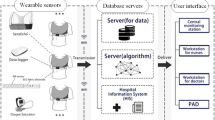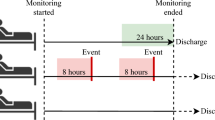Abstract
The development of intelligent alarm systems for intensive care benefits from the transformation of data from a quantitative to a qualitative mode. We constructed a computerized algorithm for the symbolization of on-line monitoring data of heart rate, systemic arterial, pulmonary arterial and central venous pressures, as well as central and peripheral temperatures. We tested the ability of the algorithm to symbolize the levels of the parameters and to detect significant long-term trends in ten adult patients admitted to the intensive care unit after cardiac surgery. The estimations of an experienced clinician were taken as the ‘gold standard’. The symbolization of the levels of the monitored parameters was in agreement with the clinician in 99.4% of the estimations. The algorithm detected 93.0% of the trends correctly and also estimated their reliability. The clinician considered its estimations to be accurate in 96.2% of cases. On the other hand, the clinician considered unreliable 2.4% of all the trends detected and classified as reliable by the algorithm. The computerized algorithm for the symbolization of real-time monitoring data performed efficiently enough for its further use in expert systems for intelligent monitoring.
Similar content being viewed by others
References
Bradshaw KE, Gardner RM, Clemmer TP, Orme JF, Thomas F, West BJ. Physician decision-making — Evaluation of data used in a computerized ICU. Int J Clin Monit Comp 1984; 1: 81–91.
Mäkivirta A, Koski E, Kari A, Sukuvaara T. Robust Signal-to-Symbol Transformation Using Median Filters. Proceedings of the International Federation for Automation and Control (IFAC) workshop on Decision Support for Patient Management: Measurement, Modelling and Control; 1989 Aug 31–Sept 2; London. London: British Medical Information Society, pp. 91–104.
Kalli S, Sztipanovits J. Model based approach in intelligent patient monitoring. Proceedings of 10th Annual IEEE-EMBS Conference; 1988 Nov 4–7; New Orleans.
Rodewald LE. BABY: An expert system for patient monitoring in a newborn intensive care unit [dissertation]. Urbana (IL): Univ of Illinois, 1984.
Fagan LM. VM: representing time-dependent relations in a medical setting [dissertation]. San Francisco (CA): Stanford Univ, 1980.
Koski EMJ, Mäkivirta A, Sukuvaara T, Kari A. Frequency and reliability of alarms in the monitoring of cardiac post-operative patients. Int J Clin Monit Comp 1990; 7: 129–33.
Kari A, Ruokonen E, Takala J. Comparison of acceptance and performance of automated and manual data management systems in intensive care. In press.
Mäkivirta A. Towards reliable and intelligent alarms by using median filters. Espoo: Technical Research Centre of Finland; 1989, Report no.: 660, 91 p.
Fukui Y, Masuzava T. Knowledge-based approach to intelligent alarms. J Clin Monit 1989; 5: 211–6.
Schreiber PJ, Schreiber J. Structured alarm systems for the operating room. J Clin Monit 1989; 5: 201–4.
Philip JH. Overview: Creating practical alarms for the future. J Clin Monit 1989; 5: 194–5.
van der Aa JJ, de Vries A, Gravenstein JS. Towards more sophisticated monitoring alarms. J Clin Monit 1986; 2(4): 304–5.
Ferrari HA. ‘Closed-loop’ computerized intensive care system after open-heart surgery. J Clin Monit 1987; 3(4): 298–9.
Gallagher NC, Wise GL. A theoretical analysis of the roperties of the median filters. IEEE transactions on acoustics, speech and signal processing. 1981; ASSP–29(6): 1136–41.
Mäkivirta A, Koski E, Kari A, Sukuvaara T. Evaluation of the median filter as a preprocessor for a patient monitor limit alarmer in intensive care. In press.
Milholland K. Assessing the impact on nursing practice of CDMS. Int J Clin Mon Comp 1986; 3: 191–7.
Author information
Authors and Affiliations
Rights and permissions
About this article
Cite this article
Koski, E.M.J., Mäkivirta, A., Sukuvaara, T. et al. Development of an expert system for haemodynamic monitoring: computerized symbolization of on-line monitoring data. J Clin Monit Comput 8, 289–293 (1991). https://doi.org/10.1007/BF01739130
Accepted:
Issue Date:
DOI: https://doi.org/10.1007/BF01739130




